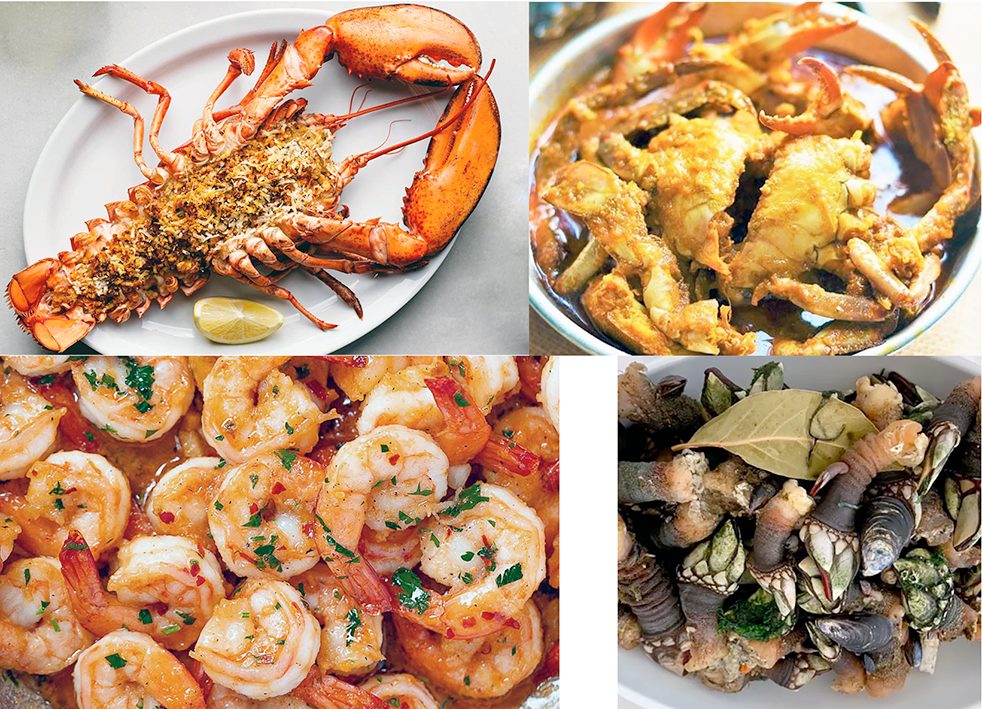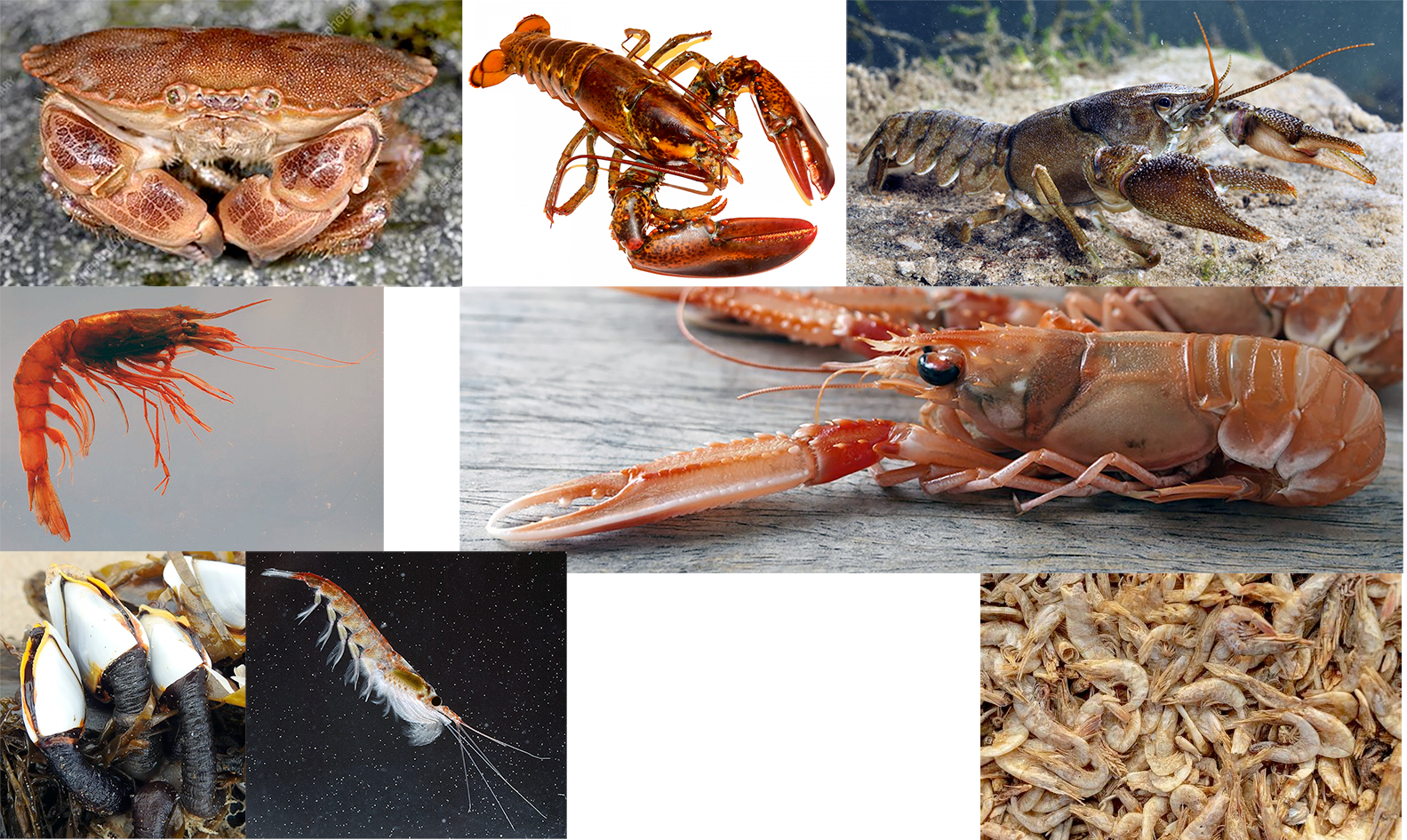FabulousFusionFood's Crustacean-based Recipes 6th Page
 top: Grilled lobster, crab curry. Bottom: garlic prawns, boiled gooseneck barnacles.
top: Grilled lobster, crab curry. Bottom: garlic prawns, boiled gooseneck barnacles.
Welcome to FabulousFusionFood's Crustacean-based Recipes Page —Crustaceans (from Latin meaning: "those with shells" or "crusted ones") are invertebrate animals that constitute one group of arthropods that are traditionally a part of the subphylum Crustacea (/krəˈsteɪʃə/), a large, diverse group of mainly aquatic arthropods including decapods (shrimps, prawns, crabs, lobsters and crayfish), seed shrimp, branchiopods, fish lice, krill, remipedes, isopods, barnacles, copepods, opossum shrimps, amphipods and mantis shrimp. The crustacean group can be treated as a subphylum under the clade Mandibulata. It is now well accepted that the hexapods (insects and entognathans) emerged deep in the crustacean group, with the completed pan-group referred to as Pancrustacea. The three classes Cephalocarida, Branchiopoda and Remipedia are more closely related to the hexapods than they are to any of the other crustaceans (oligostracans and multicrustaceans).
Most crustaceans are free-living aquatic animals, but some are terrestrial (e.g. woodlice, sandhoppers), some are parasitic (e.g. Rhizocephala, fish lice, tongue worms) and some are sessile (e.g. barnacles). The group has an extensive fossil record, reaching back to the Cambrian. More than 7.9 million tons of crustaceans per year are harvested by fishery or farming for human consumption, consisting mostly of shrimp and prawns. Krill and copepods are not as widely fished, but may be the animals with the greatest biomass on the planet, and form a vital part of the food chain. The scientific study of crustaceans is known as carcinology (alternatively, malacostracology, crustaceology or crustalogy), and a scientist who works in carcinology is a carcinologist.
 top l to r: edible brown crab, lobster. crayfish/crawfish; centre l to r: prawn/shrimp. langoustine;
top l to r: edible brown crab, lobster. crayfish/crawfish; centre l to r: prawn/shrimp. langoustine;bottom l to r: gooseneck barnacle, krill and West African dried prawns.
The name "crustacean" dates from the earliest works to describe the animals, including those of Pierre Belon and Guillaume Rondelet, but the name was not used by some later authors, including Carl Linnaeus, who included crustaceans among the "Aptera" in his Systema Naturae. The earliest nomenclatural valid work to use the name "Crustacea" was Morten Thrane Brünnich's Zoologiæ Fundamenta in 1772, although he also included chelicerates in the group.
The traditional classification of Crustacea based on morphology recognised four to six classes. Bowman and Abele (1982) recognised 652 extant families and 38 orders, organised into six classes: Branchiopoda, Remipedia, Cephalocarida, Maxillopoda, Ostracoda, and Malacostraca. Martin and Davis (2001) updated this classification, retaining the six classes but including 849 extant families in 42 orders. Despite outlining the evidence that Maxillopoda was non-monophyletic, they retained it as one of the six classes, although did suggest that Maxillipoda could be replaced by elevating its subclasses to classes. Since then phylogenetic studies have confirmed the polyphyly of Maxillopoda and the paraphyletic nature of Crustacea with respect to Hexapoda. Recent classifications recognise ten to twelve classes in Crustacea or Pancrustacea, with several former maxillopod subclasses now recognised as classes (e.g. Thecostraca, Tantulocarida, Mystacocarida, Copepoda, Branchiura and Pentastomida).
Many crustaceans are consumed by humans, and nearly 10,700,000 tons were harvested in 2007; the vast majority of this output is of decapod crustaceans: crabs, lobsters, shrimp, crayfish, langoustine and prawns. Over 60% by weight of all crustaceans caught for consumption are shrimp and prawns, and nearly 80% is produced in Asia, with China alone producing nearly half the world's total. Non-decapod crustaceans are not widely consumed, with only 118,000 tons of krill being caught, despite krill having one of the greatest biomasses on the planet. Krill are, however, a speciality in China and Japan and are used pickled in Korea. They are also consumed in Artic regions and are being introduced to new consumers as fusion recipes using frozen and tinned krill. Gooseneck barnacles (Pollicipes pollicipes) are a speciality of Spanish cuisine (recipes including krill and gooseneck barnacles can be found in the links below). The Pacific goose barnacle, Pollicipes elegans is also consumed, particularly in Alaska. The Japanese goose barnacle, Capitulum mitella is eaten in Japan. The Chilean giant barnacle or picoroco (Austromegabalanus psittacus) is routinely fished for food. Woodlice are sometimes consumed by foragers. Dried prawns (locally known as crawfish) are used as a flavouring and thickener in West African stews.
The alphabetical list of all the Crustacean-based recipes on this site follows, (limited to 100 recipes per page). There are 550 recipes in total:
Page 6 of 6
| Tam Som (Lao Green Papaya Salad) Origin: Laos | To Dress Crab Origin: British | Ulkoy (Palauan Shrimp Patties) Origin: Palau |
| Tandoori King Prawns Origin: India | To make Verjuyce. Origin: Britain | Ulkoy (Filipino Shrimp Patties) Origin: Philippines |
| Tandoori King Prawns Origin: Britain | Tom Yam Goong 1 Origin: Thailand | Urap (Steamed Vegetables with Coconut) Origin: Brunei |
| Tapado (Seafood Soup) Origin: Guatemala | Tom Yam Goong 2 Origin: Thailand | Vary sy laoka malagasy (Malagasy Prawn Curry with Vanilla Rice) Origin: Madagascar |
| Taro aux Fruits de Mer (Taro with Seafood) Origin: Cote dIvoire | Tom Yam Goong 2 Origin: Thailand | Victorian Green Saag with Prawns Origin: Anglo-Indian |
| Teisennau Cranc wedi'u Grilio (Barbecued Crab Cakes) Origin: Welsh | Tom Yam Goong Maenam Origin: Thailand | West African-style Barbecue Sauce Origin: African Fusion |
| Terung Saus Santan (Fried Aubergines with Coconut Milk) Origin: Papua | Tom Yum Talay (Fish Stew) Origin: Thailand | Whitebeam Berry Jelly Origin: Britain |
| Thai Green Curry of Prawn and Fish Origin: Thailand | Trassie Trafasie (Suriname Shrimp Paste Sauce) Origin: Suriname | Wouré Burakhè Magilinri (Sweet Potato Leaf Sauce) Origin: Guinea |
| Thai Green Curry Paste Origin: Thailand | Traybake Keralan Fish Curry Origin: Fusion | Xinxim (Brazilian Chicken and Crayfish in Peanut Sauce) Origin: Brazil |
| Thai Green Curry Paste II Origin: Thailand | Trini Curried Shrimp Patty Origin: Trinidad | Yétissé de Poulet (Chicken Yétissé) Origin: Guinea |
| Thai Hake Bites Origin: South Africa | Trinidadian Crab Backs Origin: Trinidad | Yambo Origin: Aruba |
| Thai Mango Fish Curry Origin: Thailand | Trinidadian Fried Wontons Origin: Trinidad | Yebeh (Yam and Fish in Red Palm Oil) Origin: Sierra Leone |
| Thai Pork Curry in the Burmese Style Origin: Myanmar | Trout Kedgeree Origin: Britain | Z'habitants (Martinique Callaloo) Origin: Martinique |
| Thai Red Curry Paste Origin: Thailand | Turkey and Yam Pepper Soup Origin: Nigeria | Zarzuela de Mariscos (Seafood Zarzuela) Origin: Spain |
| Thai Red Curry Paste Origin: Thailand | Tuvaluan Crab Curry Origin: Tuvalu | Zavla (Dried Prawn Curry) Origin: India |
| Thai Yellow Curry Paste Origin: Thailand | Udang Masak Lemak Nenas (Pineapple Prawn Curry) Origin: Malaysia | Zupa di Pesce (Seafood Soup) Origin: Cayman Islands |
| Thai-style Red Seafood Curry Origin: Fusion | Ukaeb (Minced Crab with Coconut Cream) Origin: Palau |
Page 6 of 6